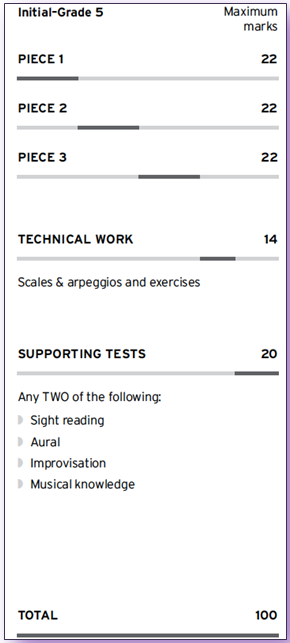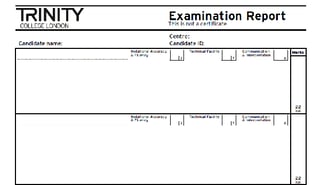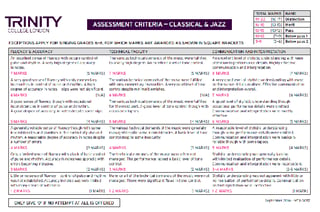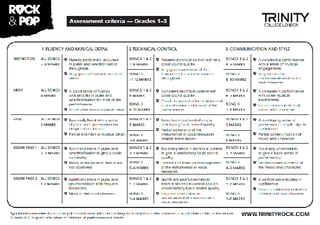
How to turn a Pass in to a Distinction in your Trinity graded music exam

BY: Jean McCreery
26 July 2017
PLEASE NOTE: AN UPDATED VERSION OF THIS BLOG POST CAN BE READ HERE.
It’s exam day. This is it. After weeks of practice on your students are going to be put to the test to see how much you have learnt.
Have you ever spent an exam day wondering how your students performed? Did they play what the examiner wanted to hear? Did they earn that extra mark that could make the difference between a Merit and a Distinction?
Having a good understanding of what the examiner will be assessing in Trinity's graded music exam helps to focus practice and sets your students up for a great performance on exam day.
So, lets breakdown how your Trinity graded music exam is structured and explore what the examiner will be looking for during your performance and how the marks are calculated.
Skip to Rock & Pop
On your marks…

This summary shows you a breakdown of how the marks are distributed across the various elements of your Trinity graded music exam.
You can see that for each of the three pieces that you play you can achieve a maximum of 22 marks, so a total of 66 to aim for. We will look at how those marks are assessed further on.
Your Technical work assesses your scales, arpeggios and exercises and will be marked out of a maximum of 14. Finally, there are two Supporting tests to complete with each worth up to 10 marks, for another potential 20 marks to add to your total.
If you achieve the maximum available in each area you'll get a perfect 100!
Here’s how your final mark translates to an attainment level:
- 87-100 Distinction
- 75-86 Merit
- 60-74 Pass
How your pieces are assessed

Take a look at an example report form that your examiner will be using for your Trinity graded music exam.
If you look at the marks for the pieces you can see that the maximum of 22 marks you can achieve per piece is distributed across three individual assessment areas:
- Notational Accuracy & Fluency (Max. 7 marks)
- Technical Facility (Max. 7 marks)
- Communication and Interpretation (Max. 8 marks)
This approach enables the examiner to consider independently these three very important aspects of your performance.
Assessment Criteria
I would recommend you also take a look at the Assessment Criteria we use when marking, to help you focus as you continue to develop your playing skills over the next few weeks.
This is a valuable tool to use with your own students too as it will help demonstrate at what level they are currently performing in relation to their graded music exam.
We’ll take a look at this in more detail in a future blog post.
Rock & Pop Exams
As you should know by now, within your Rock & Pop exam you will be expected to perform a set of three songs and one of the Sessions skills assessments – which could be either Playback or Improvising. You can choose the order of your set list.
Here is a breakdown of how the marks are allocated:
| Component | Option | Pass Mark | Maximum Mark |
| Song 1 | Choose a song from the relevant Trinity Rock & Pop book or from www.trinityrock.com/downloads and perform it with the backing track. |
15 | 25 |
| Song 2 | Choose a different song from the book or from www.trinityrock.com/downloads or perform a song you have chosen yourself or perform a song you have composed yourself. For Song 2 you may choose to sing and play, e.g. by adding vocals to playing keyboards or adding a guitar accompaniment to your vocals. |
15 | 25 |
| Session Skills | Choose either Playback or Improvising. | 12 | 20 |
| Song 3 | Choose one of the two Technical Focus songs from the book, which cover three specific technical elements, and perform it with the backing track. | 18 | 30 |
| Total | 60 | 100 | |
For Songs 1 & 2 and your Technical Focus song there are three different assessment areas that the examiner will be marking:
- Fluency & Musical Detail
- Technical Control
- Communication & Style
Each area has its own criteria for the examiner to evaluate, and it’s the same for your chosen Session Skills. We will introduce each aspect of the exam in future blog posts but you can preview them here:
Download the Criteria Card for Songs
Download the Criteria Card for Session Skills
Here’s how your final mark translates to an attainment level:
- 87-100 Distinction
- 75-86 Merit
- 60-74 Pass
So now you have an idea of what your examiner will be assessing on your exam day and where your marks will be earned.
You can use the assessment criteria I have included to help you focus your practice to where you can make the most improvement over the coming weeks.
Remember, just 1 extra mark earned from your examiner could mean the difference between a Pass, Merit or Distinction!




Comments & Replies